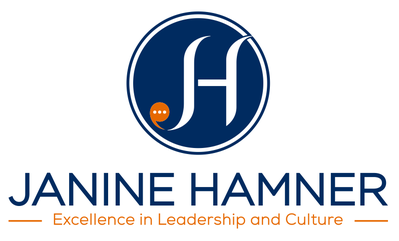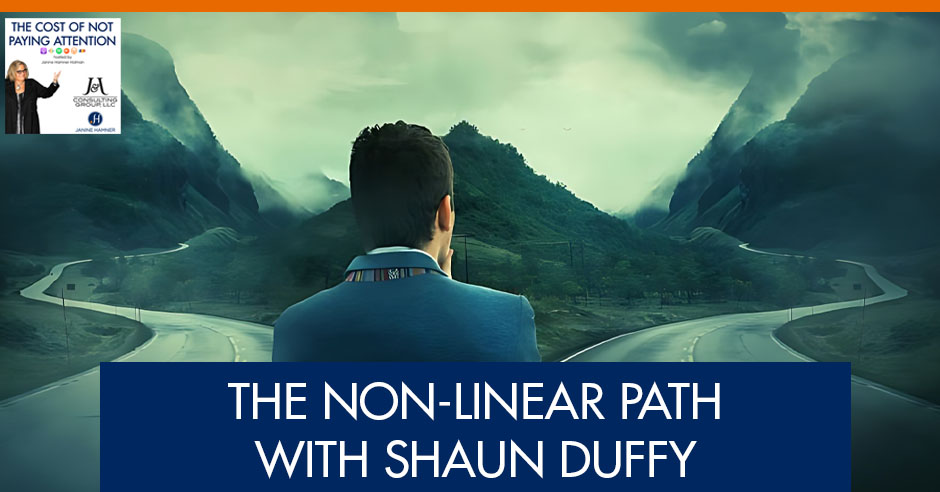
Are you worried that you don’t exactly have a “linear” path in life? Do you feel indecisive and want to do multiple totally different things in this lifetime? Well, as Daniel Kahneman says, we are living in a non-linear world. In this episode, Shaun Duffy talks about his life journey and what it’s like to be on a non-linear path. He shares his thoughts on getting to know people, why we have so many paths, and what it means to be self-actualized. Shaun is a self-taught American abstract expressionist painter with over thirty years of experience creating hundreds of unique artworks. As an inventor and entrepreneur, Shaun pioneered the live-streaming sports video industry, creating the world’s first live-streaming subscription service for hockey rinks called Rinkview.Com. Tune in to our conversation with Shaun and learn all about non-linear pathways!
GUEST: Shaun Duffy | Visit their Website: https://shaunduffy.com/
HOST: Janine Hamner Holman | [email protected] | LinkedIn, Facebook, Instagram, and Twitter
—
Listen to the podcast here
The Non-Linear Path with Shaun Duffy
What am I paying attention to in this episode? Getting to know people in non-linear pathways. If you read our last episode with Steve Pappas, you heard me and Steve talk about how critical it is for the financial well-being of organizations that leaders get to know their people. People have fascinating stories, and sharing our stories and being heard is part of what has people feel, seen, feel and know that they belong.
I am often asked how I got to where I am now or how I got to be who I am now. It’s a linear story and it starts in high school. Shaun Duffy, our guest for this episode, and I went to junior high and high school together, or at least we attended the same school at the same time. Shaun and I are going to talk about that a little bit.
Shaun Duffy is a self-taught American Abstract Expressionist Painter with many years of experience in creating hundreds of beautiful and unique artwork pieces. He is an inventor and an entrepreneur who got his start by pioneering the livestream sports video industry creating the world’s first streaming subscription for hockey rinks called RinkView.com.
In the mid-1990s, Shaun worked in the former Soviet Union for Global One Russia and was involved in nuclear and biological weapons proliferation prevention. While living in Russia, he became friends with the Azerbaijani/Russian Master Artist Tahir Salahov. It was through the encouragement and support of Tahir that Shaun decided to pay attention to his creative spirit.
—
Welcome to the show, Shaun.
Thank you very much. It’s a pleasure to be here with you.
You are welcome. I am thrilled that we made this happen. Shaun and I were chatting a little bit before we started recording. The last time that we were together in the same space was a little more than 40 years ago. It would’ve been our high school graduation. At that point, Shaun was an athlete. Were you on the hockey team?
Yes, I was on the hockey team.
You were a hockey star.
We had a very good hockey program. It was very hard to make the team there but I was groomed for hockey my whole life. I grew up with a great hockey star. My father, Jimmy Duffy, was a Boston College star hockey player. He grew up in Cambridge, went to Range, and was heavily recruited. He had an amazing career in hockey. Not only playing but he was a referee for years. He coached hockey at Framingham State for many years. He also worked at the phone company.
We had a rink in the backyard. My older brother was a star hockey player. We played sports all the time. We played hockey and baseball. At that time, athleticism was such a big valued thing for students. Back then, it was important to the educators to get people in the school who could play a sport.
We had an extraordinary athletic director who was an ex-Marine. He’d always talk about sports. Being an athlete, and being proud of my athleticism, I enjoyed that. Unfortunately, I had a severe injury playing hockey during high school.
I don’t remember that at all.
I kept playing. It happened during my sophomore year and it cut my career short. I severely broke my arm and my wrist in multiple places and it never was the same. It took the love of the game a little bit out of my heart. I often say that might have been God’s way of guiding me to be an artist.
It got you on a different path.
That’s maybe how I was led into the art world but I continued to play. I played a little in college. Mostly on the JV team. I played a lot afterward. I played some “semi-pro hockey.” A big part of my identity was being a hockey player and I loved it. Most of my friends are hockey players, and ice hockey produces an interesting group. Bowling does the same thing. You hang around like-minded people.
Agreed. Scuba diving is the thing for me. It’s an interesting group of people.
I love diving. We’re going on a big trip to Hawaii to do some diving.
But in high school, I wish I had studied Russian more because I ended up having a career in Russia, working there, and doing a lot of important government and commercial-related work. I was the worst student in the class. We had a Russian princess in our class. Do you remember Tatiana?
I do remember Tatiana.
She was wonderful. She would help me with Russian. I wish I’d studied harder, I wish I’d done more art projects, and more acting. I missed a lot of those opportunities. I was in the Rocky Horror Picture Show. I don’t know if you remember that but somebody has a photo of that. I’ll find it.
What are your recollections of those days? What else do you remember? It’s foggy for me.
There is. Thinking back, a lot of what I remember are impressions, like your art, it’s impressionistic in my brain. When we were in high school, there was not a lot of bullying going on.
There was a little. It was overlooked a lot.
It was more covert. It was less overt than it is now. We were in high school long before social media. It was also very stratified. You had the super elite group of kids, lots of kids in the middle, and then some kids down at the bottom who were mostly stoners in my impressionistic recollection. There weren’t very many of them. This idea probably got carved in my brain, 7th or 8th grade.
The kids who were in the uber-popular crowd was where everybody wanted to be. To tell the truth, that is the group that you were part of, and I was not. To be in that group, you had to be pretty, smart, and an athlete. In high school, Shaun, you were very pretty. I have some photos of us from high school. You’re still an attractive man and, in high school, he was very handsome. Long ago, I gave up the idea of being an athlete. I rode crew in junior high and in high school.
I ran in the off-season in order to be able to row because even though people think rowing is about upper body strength, it’s all in your legs. That was my sport but it’s hard to continue rowing after high school and/or college. I’m not a natural-born athlete. That’s not part of my identity.
I’ve struggled with my weight my whole life. I was a bit of a chubby kid. My weight has been up and down my whole life. Given our Western American view of what beauty is, I gave up on being beautiful a long time ago. The one thing I had was that I was smart. I know I’m smart. Along the way, there’ve been a couple of things that challenged that for me. One of my mentors said to me, “What would happen if you weren’t smart?”
Immediately, the thing that came out of my mouth was, “I would be a waste of space.” After I said it, I thought, “That’s quite a condemnation.” Certainly, on many levels, it’s not what I thought but I realized I am holding on to this idea of what it was to be popular when we were in junior high and high school.
Talking about this is giving me an emotional reaction. When you and I started talking about getting together, this kid, me, who was somewhere in the lower part of the middle of the stratification, and you, who was one of the uber elite popular kids, I thought, “This could be cool to have a conversation about some of that.” Also, about how it was to be “popular” in your teen years and where your life has gone from there. When we are teenagers, we have these ideas of what our life is going to be and how much things matter. Things matter so much when we’re that age.
I followed everything you said, and you may have thought I was at the top. It’s almost like being famous. You then talk to famous people who say, “It sucks. I hate being famous.” Nobody enjoys it. I never thought I was popular. I was an insecure kid. I didn’t even think I was pretty. I thought I was ugly. I looked at myself and I’d say, “I’m skinny.”
This is the ironic part of this story. Maybe it will be educational to some people. It isn’t obvious to everyone but everyone is deep down a little bit afraid that they’re not going to fit in or be accepted. It goes way back to our cave-dwelling ancestors who build the community. Social hierarchies are nothing new. We humans did not invent the social hierarchy.
Deep down, everyone is a little afraid that they will not fit in or be accepted. Share on XWe did not. Watch our animal friends.
That’s been encoded in all of the flora and fauna. It is almost like our brains are playing a trick on us. It’s like you’re an unwitting participant in harmonizing and somehow creating this order that possibly is going to be harmonious, yet it’s chaotic. It’s mostly brain chemicals and hormones.
They used to call them disorders. Now we’re learning that there are learning differences in kids. I never knew it until I was much older. Until my kids were learning about that. We’ve done the best we can. We’re putting kids in a building while the parents can go live their life for eight plus hours to try to make a living. I know folks who’ve done homeschooling. There’s mixed success like in high school. It’s a personal choice.
When I think back on those times, we all wanted to be loved. We all wanted somebody to love us and we got that from many of our teachers. Most of us had good parents. You could get loved by being a good athlete or by scoring a goal. You could get loved by wearing hot pants that week. You could get love if you got an A on the test. There were some kids who were so smart. There was this one kid who was a genius. He looked like the classic absentminded professor. He graduated from 4th grade to 7th grade.
He was a big, tall kid. He would do 25 Math problems in the five minutes between classes. One time, we had to memorize, “To be, or not to be, that is the question. Whether ’tis nobler in the mind to suffer the slings and arrows of outrageous fortune,” in Mr. Lit’s English class. We all had to memorize it. It took a week to try, then you had to write it on the blackboard in perfect punctuation and spelling and old English.
His name was close to mine and so he was going after me. I said, “Are you ready to do your thing?” He said, “I forgot to practice for it.” He grabbed my book of Hamlet, looked at it for five minutes, and handed it back to me. His turn to go and do it. He was the only one who did that perfectly. This guy was fascinating. He ended up not being popular and he was considered different even though he was a genius.
Do you have to have the trifecta? I guess so because that way, you have no vulnerability.
Except you did.
We all did.
You were the trifecta. This is not a key part of your personality anymore, which is why I can say this easily to you. You were the walking embodiment of that trifecta at that point. You were also insecure and you were also wanting to feel accepted, which is ultimately what we all want.
We always look for the value that we can bring to things. We’re talking about the classic Greco-Roman classical education. The high school we went to was an exclusive school. It’s considered the third best private school in the country now, believe it or not. It’s insane but I don’t know what students, athletes, or models they’re producing. It’s a different place. Schools have changed that curriculum. They’ve had to move up the timeline to more modern ideas and more relevant topics that are going to be relevant to people now.
In my artwork, the creation of mythology is a big thing. And we recall Homer’s Odyssey and other word of mouth created myths we studied in high school. This is how we create myths, through word of mouth. Growing up in Massachusetts, we lived through the myth of John F. Kennedy. We weren’t around when some of the myths that we live by were created, and the structure that was in place that propelled some of those ideas now is gone.
When that, “I would be a waste of space,” came out of my mouth, part of what was so shocking to me about that was that I don’t care if people are pretty, athletic, or smart. What I care is that they’re good people. They’re interesting, interested, and curious. Those are some of the things that I love and enjoy about myself.
Part of what I love about your journey from an athlete to an artist is that there must have been some real curiosity that got sparked in you because that’s a big leap for a hockey player to become an expressionist artist.
Interestingly enough, it was sparked during that time in Cambridge with my friends. Where I grew up, I was groomed to be the athlete, play sports, and get a scholarship to college. I had never seen original artwork, even though my grandfather was a painter. My mother’s father was an artist but he died very young and his work was sold off. She didn’t even have an example of one of his pieces, sadly. That is tough, but my poor mom pushed me a little bit in that direction.
I had friends whose parents were deans of several houses at Harvard and of Radcliffe. We knew some people there. I would call my friend whose mom was a high-level person at Radcliffe. I remember one time Julia Child answered the phone. I asked, “Is Tia there?” Going into some of those people’s homes, that was for me, the moment.
Later on, after I finished college, I went to Italy for a few weeks and I also had an amazing experience seeing all that I saw. I also remember that back in high school, we had an Art History class with Mrs. Kaufman. I don’t know if everyone had to take that but she was a fine educator, very tough and strict on me for whatever reason. She wasn’t giving me any passes.
I found Medieval History and Art History fascinating. Despite the probably terrible comments that she made, I enjoyed it and I found it interesting. Those experiences benefited me. I then went off to college and luckily I had taken Russian for four years. That helped me later in my career when I went into business. Things that led to what happened one bit at a time, little things build up.
How did you get to Russia?
I worked at Sprint for some time, managing some of their international accounts. Global One was a joint venture between Sprint, Deutsche Telekom, and France Telecom. It was the first international telecom company. Even just a little, I had some experience in the space that I was in, which was telecommunications and data communications.
I took it. I went over there and ran the sales and marketing division for the local, global, and Russian departments. I moved into more of a director role in the Government Services Division where I started working. The commercial stuff was cool. Coca-Cola, Caterpillar, Mary Kay Cosmetics, and everyone was coming into Russia in the ‘90s and there was a lot of hope.
I didn’t want to talk about the war but it’s very disappointing because we thought it would take them 30 years to realize democracy. Unfortunately, the opposite has happened. At the time, there was a lot of hope for cooperation. There was a real problem; all these horrible weapons were sitting there unattended and unwatched.
A lot of that stuff went missing, believe it or not, frighteningly enough. There were several projects that I got to be involved in. Many of them are still classified. I can’t talk about too much but it was mostly helping the Commonwealth of Independent States, the newly independent states including Russia, to modernize its computer, telecommunications, and data networking capabilities. The money was mostly funded by the US to help them to stabilize, secure, track, and monitor all of their “dangerous assets.”
I was running a few programs. It was fun work and I got to meet some cool people. I felt good about what we were doing. There was this one program called the Partnership for Proliferation Prevention. It was where an American Naval Admiral would spend three months with a Russian Army commander to live with each other’s families in each country, spend time with each other, and talk about ways to deconstruct the entire network that was in place to kill each other.
Realizing how unsafe the world really is can change your course and can change everything. Share on XI got to know these guys and I worked with them to help with some projects they were doing. I used to go out to dinner and drink vodka with these guys. We were having dinner, drinking vodka, and talking with the general in charge of the nuclear war planning versus the United States. We’re out in Moscow, having fun, drinking, laughing, and joking like, “Everything’s going to be okay now because we’re all working together.” It was a great time. Everybody had hope.
I asked this general, “Were you guys going to wipe out the whole country, or were you going to leave some places?” He replied, “Shaun, you are from Boston, yes?” I said, “Yes.” He then said, “We were going to spare Boston.” We laughed like hell. I had other crazy experiences over there like running into “America’s Most Wanted” people in bars.
This story is revelatory to me. I did not know that was going on.
It helped my artwork because it made me realize how dangerous the world is.
I want to explore that. Often in the work that I do working with organizations, we talk about getting to know people. You and I have known each other for many years, I now know you much better than I did an hour ago. I hope sitting here, that you and I will stay in touch in a way that we never would have if this conversation hadn’t happened.
Once we get to know people and their stories, it changes the relationship in fundamental ways. When we’re thinking about nuclear non-proliferation or what makes an organization healthy, thriving, and financially stable, a lot of it is about getting to know people and their stories because then people feel connected. They feel like they belong.
They’re so much less likely to push a button and vaporize a nation. They then understand like, “You were late on that project and I know what’s going on in your life, so I have an understanding of why you were late on that project. We are going to talk about the fact that you were late but now I have a context in which to think about that.”
My first job out of UVM was working for the phone company in New York. It was New York City in the ‘80s. My manager lived on Long Island and was involved in his synagogue. He wasn’t exactly a Rabbi. I don’t know what they call it, it’s like a lay Rabbi (Gabbai). My job was to sell stuff. He didn’t care anything about what I sold. He just wanted to connect with me and get to know about me as a person.
He would say, “Shaun, what are we doing? When are you going to get a girlfriend? When are you going to stop doing all this? You’re five minutes late again.” He was more interested in my life and the mentorship but those days are gone. It’s a fundamental change in the way corporations treat people and the way people treat corporations. There’s a disconnect now.

Non-Linear Path: There’s a fundamental change in the way corporations treat people and the way people treat corporations. There’s a disconnect now.
I personally think that it has something to do with the way that we tax. The multibillionaires are making millions of dollars by selling corporations and then taking all the money for themselves because, before John F. Kennedy, who reduced the top marginal rate of tax from 91% to 70% for people making over a certain amount of money. CEOs couldn’t sell the company. If you were the CEO of NYNEX, or New York Telephone at the time, it didn’t matter. If you got $200 million, you could only keep 9% of it and that’s changed.
Now the corporate world has become cutthroat and callous. Entrepreneurs or startups, that’s a different animal but I’ve been through it all. I’ve been in business. I’ve done a startup. It’s a hard place to get people to work together and to be successful. With everything done online, keeping people is difficult. It’s about having real contact with the people with whom you work, trusting them, giving them a chance to succeed, and not overpowering their life with your management needs. Trust that the human being will get the job done. That’s always been my philosophy. I’ve managed people and companies. I let people do what they want.
These days, trust in the human being will get the job done. Share on XLet’s get back. Here you are, you’re in Russia. How is it that you ended up meeting your mentor?
I rented an apartment from Tahir Salahov when I first moved to Moscow. I lived in his place for a few years. I used to commute there for another couple of years. I spent almost five years going back and forth.
Did you know who he was initially?
I had no clue who he was. I got his apartment at the time. Folks got to cash in on the apartments that the communists would give them. He had a nice place. He lived in what was called the Dome Baryshnikov, which is the home of Baryshnikov, where Elena Baryshnikov lived. It was on a beautiful street. He was a Minister of Culture at one point in the Soviet Union. He was a high-up official.
His artwork is on the stamps in the country. He’s in the Guggenheim, MoMA, and Tretchikoff Gallery. He’s the real deal and has done some amazing work and not just painting. Anyway, I moved into his apartment and I set up my painting easily. I didn’t have much stuff. He walks by and says, “Shaun.” I told him, “I need some art supplies.” He wrote me this letter. It’s a nice letter. He said, “Go down to the street, go to this lady, and show her the letter.” I went down to this little tiny art store. It was a hole in the wall and I walk up to the lady and said, “Hello?” I hand her the piece of paper, she reads it, and then she looks up at me. She’s in shock. She says, “Tahir Salahov?” I replied, “Yes. I just need some stuff.” She goes into the room. She gives me a big box of paint supplies, which I paid for. She asked if she could keep the letter.
I knew something was up at that point. I asked, “Why do you want to keep this?” She’s told me, “Tahir Salahov. It has his autograph on it.” I said, “I better not.” I still have that letter. He wrote, “This is a young American who’s come to live in Russia. He loves to paint. He’s a wonderful painter.” I bought a lot of art supplies from her over the years. We would paint together.
We would come down and his wife would make us dinner. We would talk about his life and art. He knew everybody. He had a little book with anybody who came to Russia before like 1989. They had to go through him because he was the Minister of Culture. He had these pictures with Michael Jackson and Armand Hammer. He knew everybody but I had no clue.
I treated him like anybody else and he liked that. He loved that I was so into painting. He liked my artwork. He became a fan of it. In fact, I saw him again. I went to Azerbaijan with Martine in 2018 just before he died. He died about a year later. We went to his home on the Caspian Sea. We spent a week with him. We painted, went to his studio, and watched him paint. We had a wonderful time. He was like my Wizard of Oz.
He told me it was okay. He said, “You’re great. You’re an awesome painter, Shaun. You’re amazing.” I reminded him of a good friend of his, Rauschenbert. They spent a lot of time together and he always said I reminded him of his friend. Now I’m friends with his daughter, Aydan, and his grandson. They’re both incredible artists also. They’re both famous over there on their own.
Tahir was special, just a lovely man. We had a wonderful time. He grew up in Azerbaijan. His father was taken away and killed by Stalin when Tahir was about 6 or 7 years old. He told me that story one night at dinner. We were drinking this red wine, which was Stalin’s favorite red wine. It was a Georgian. It was a blood-red wine and I’ve forgotten the name of it.
Anyway, so Tahir was a high-level official, not for Stalin but under Khrushchev. He told me how his father had been kidnapped and killed by Stalin. Somebody else said he said something bad about it. I said, “How could you even work for them? I don’t know if I can do that if they killed my father.”
He looked at me and said, “Shaun, we do what we must to survive.” It was eye-opening. He is such a beautiful person and he made a difference culturally in Russia. He was a giant. For me, to have had that opportunity alone is the highlight of my art career, to have been able to paint with him and have his spirit with me.
You are making your living as an artist, yes?
I’m trying.
It’s not that easy.
I’m not good at going out and showing my work. I have an Instagram and a Saatchi gallery online where I sell my work. I’ve had some great sales. I’ve sold some lovely pieces and I’m producing every day. It’s no way to make a living, to be honest with you unless you are very lucky and find the right niche. I’m not into painting pretty pictures. I could paint. There are pictures that everyone wants and likes and I could sell them, then it becomes a job. I’m looking for some magic to happen.
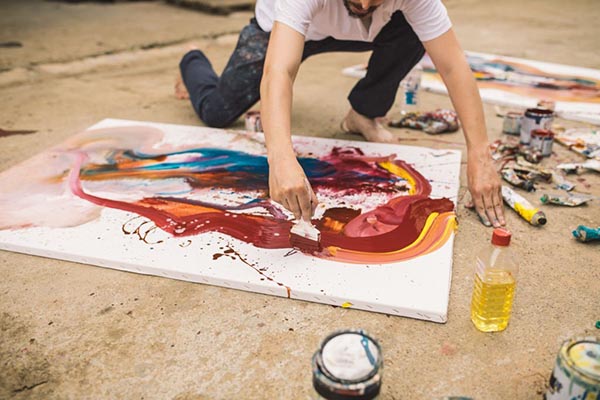
Non-Linear Path: Being an artist is no way to make a living unless you are very lucky. You could paint pictures that everyone wants and likes, but if you do, then it becomes a job. And you may lose that freedom of expression.
It goes back to the creation of mythology and how art and mythology are one thing. Every day, I’m doing my mythology studies in my artwork, seeing what comes out, and trying to tap into a bigger idea that might help through somebody’s eyes and see something beautiful. To circle back to the idea that you thought I was the superstar and you didn’t have the same sense of yourself.
Yet, we all are individuals. We all have our own consciousness. In fact, it almost seems like what Alan Watts talks about. “Our consciousness is a way for the universe to see itself.” We’re all some reflection of the universe and what else is there to do but enjoy it and be beautiful in your own way? Feel beautiful and know you’re beautiful.
Much of that idea of the popular kids is in fact a myth. You were not feeling popular, feeling secure, feeling like, “I’m Mr. Big Shot. I got it all going on.”
Back then, I felt that I was a loser. Anybody who doesn’t have doubts as a teenager is kidding themselves.
I was talking with the CEO of an organization I’m getting to work with, which is great, fun, and fulfilling. He was talking about his feelings of insecurity and his thoughts like, “What am I doing, running this $400 million company?”
Many of us, in some way or another, are dealing with some level of impostor syndrome that is part of the human condition. It is through the telling of our stories and getting to know each other as people that we get to poke through the myth and get to the heart of the human and the heart of humanity. That’s what it’s all about.
Heal yourself and you’ll heal the world. One of my favorite philosophers, who was an academic, is Joseph Campbell, who was a Columbia religious scholar. His answer was, “Follow your bliss.” That’s the message at the end of the day of all religions and all spiritual philosophies. Follow your bliss because you’re here for a very short time. Why wouldn’t you follow your bliss?
Alan Watts said, “If you make money your aim, you’re going to spend your whole life doing something you hate doing, being around a bunch of assholes you hate usually,” unless you figure it out. You love acting and dancing then you find a way to make money. If you make money your goal, you’re most likely going to be unhappy and you’re going to miss out. The point of this is you’d rather have a short life doing great fun things than have a long, miserable one.

Non-Linear Path: At the end of the day, the message is to follow your bliss. You’re here for a very short time, so why wouldn’t you follow your blessing? If you make money your aim, you’re going to spend your whole life doing something you hate doing.
Shaun, if people are interested in checking out your art, where should they go?
They can go to my website, which I don’t update as much as I should but I will be soon. It’s ShaunDuffy.com and I also have a commercial site through SaatchiArt.com/ShaunDuffy. You can go to that page to see probably about 80 of my works there. My website may have 50 or 60 pieces. I make them so fast that I can’t get them up on my website. If anybody likes a piece or wants a commission, I’d love to do large pieces. I’m in it for the love.
Great leaders make great teams. Share on XGo check them out. Shaun, it has been a delight. Thank you so much for sharing your story.
It’s a pleasure. I know we’re going to keep in touch. I wish you the very best of luck with your show. I can’t wait to read this one when it comes out. If I can ever be of service or do anything to assist, please do not hesitate to call me.
This has been the Cost of Not Paying Attention. Remember, great leaders make great teams. Until the next episode.
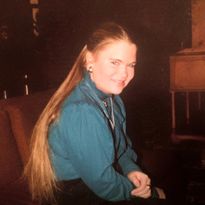
Janine in High School
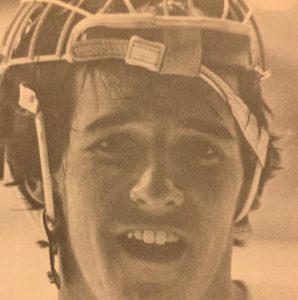
Shaun in High School

Shaun Jr High Graduation
Important Links
About Shaun Duffy
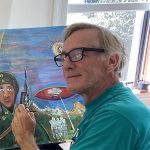 Shaun Duffy is a self taught American abstract expressionist painter with over thirty years experience creating hundreds of unique artworks. An inventor and entrepreneur, Shaun pioneered the live streaming sports video industry creating the worlds first live streaming subscription service for hockey rinks called Rinkview.com. In the mid 1990s Shaun worked in the former Soviet Union for Global One Russia and was involved in nuclear and biological weapons proliferation prevention.
Shaun Duffy is a self taught American abstract expressionist painter with over thirty years experience creating hundreds of unique artworks. An inventor and entrepreneur, Shaun pioneered the live streaming sports video industry creating the worlds first live streaming subscription service for hockey rinks called Rinkview.com. In the mid 1990s Shaun worked in the former Soviet Union for Global One Russia and was involved in nuclear and biological weapons proliferation prevention.
While living in Russia he become friends with the Azerbaijani – Russian master artist Tahir Salahov. It was through the encouragement and support of Tahir that Shaun decided to pay attention to his creative spirit.
Shaun is also a father of two wonderful young adults, Jake 24 and Anna 22 and married to his amazing wife, Martine.
